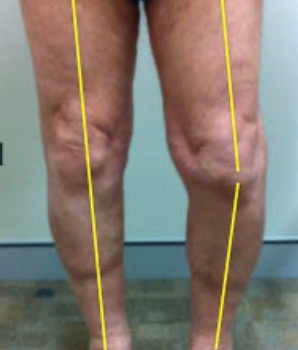“Is Running bad for your knees?”
Is Running bad for your knees?
A recent article in the Times recently resonated with a question that I have been asked many times by patients who know of my interest in running, “Isn’t running bad for your knees?” No doubt a number of you will take up some exercise in the new year and may ask yourself this question and what should I do? I always suggest that you first ask yourself “what do I like doing?” as you are more likely to continue this.

For this item I am referring to wear and tear damage and Osteo arthritis in which there is loss of the articular cartilage that is like a teflon lining of the joint. Without it the bone is exposed and this causes pain. A typical arthritic knee will be thickened and generally lose the ability to fully straighten, quite often be slightly bow shaped, as demonstrated in this picture.
I can understand where this question comes from as the thinking is that simple repetition of steps could potentially cause damage. However, a simple controlled run is less likely to cause damage compared to a footballer who will often run 10k during a football match, but they add changes of direction, sudden changes of speed, extreme ranges of movement and traumatic blows from others.
For distance runners the impact is shared through various shock absorbers, the Shoes, the arches in your feet, the ankles that naturally pronate (this is only an issue where it is excessive or uncontrolled) knees, hips and the shape of the spine. Different individual styles of running will determine how these systems are used and where load is absorbed. Muscle strength then controls this joint function. This where professional advice can identify things that can be adapted if necessary.
All sports involve micro damage to tissue and this is part of building / training muscle as the 24 hours after the exercise is when the repair process actually builds the muscle / tissue. However, traumatising the tissue again in this period prevents that repair process. Problems come when the participation becomes an obsession, with excessive distances and insufficient rest periods (varies according to age) and insufficient dietary intake to support the level of running. There is a condition called REDS (Relative Energy Deficient Syndrome) in which the body has to break down it’s own tissue to provide energy as it is not being supplied with enough nutritional energy to repair itself and a breakdown cycle starts.
Running (and most sports) has many attributes that outweigh any potential wear and tear. Maintaining muscle strength to control joint movement, weight control (massive cardio, hormonal, self-esteem elements) and mental health positives. Patients will often express that their “knees have gone” however frequently this is not the case, but they have got into a cycle where some discomfort resulted in them doing less movement, feeling stiffer, loss of muscle strength etc etc with the result that their weight increased and hence the load on their knees increased. Every bit of weight that can be lost makes a massive difference to the load experienced on a knee joint.
All joints benefit from movement, the membrane that lines the inside of the joint secretes the Synovial fluid in response to movement. We feel stiff after rest or sleep, but with some movement we soon forget that sensation. This is why a warm up period at the start of exercise should always be incorporated.
Most arthritis can be attributed to genetic elements or previous trauma. A footballer subjects their leg joints to numerous traumas, forceful bending and twisting is responsible for most meniscal damage, loss of meniscus will result in damage to the articular cartilage. This is why you will see many 50 plus year olds walking around with distinctive bow legs as the body adapts to try and use a part of the knee surface that is not damaged. The present generation of 60+ year olds were active sports people at a time when open surgery for knee meniscus damage was carried out, that in itself was enough to cause significant damage to the knee and hence many of them are now having replacement knees.
Unfortunately, there is no clear evidence that supplements such as Glucosamine and Chondroitin make a difference. Anecdotally I hear people say they had an immediate difference, or who knows if they might be worse if they hadn’t taken them or definitely no change. There have not been significant independent studies.
Generally, the rule of moderation is best observed, but also where running is concerned, listen to your tweaks and niggles that will commonly be soft tissue related. Adapt to the conditions you are running, a mountain run on rough ground with steep ups and downs will be more traumatic and needs to be developed. Seek advice from the practitioners at the clinic, where we have a wealth of knowledge and experience.
Mark Pitcairn-Knowles
Osteopath and Athletics Coach
Related posts
TOP FIVE REASONS WHY YOU SHOULDN’T USE COTTON BUDS
Dr Jay Jindal Au.D. FSHAA, Consultant Audiologist In a survey in South East England, it was found…
Ongoing Procedures During Covid
We are sure everyone is relieved now that life is returning to some form of…
Staying Mobile Whilst Working From Home
Catherine Alexander, Sports Massage Therapist Sitting at your desk for prolonged periods of time can…
Mild Muscle Tear Advice
by Mark Pitcairn-Knowles (Osteopath) One of my other roles is as an Athletics Coach at…

